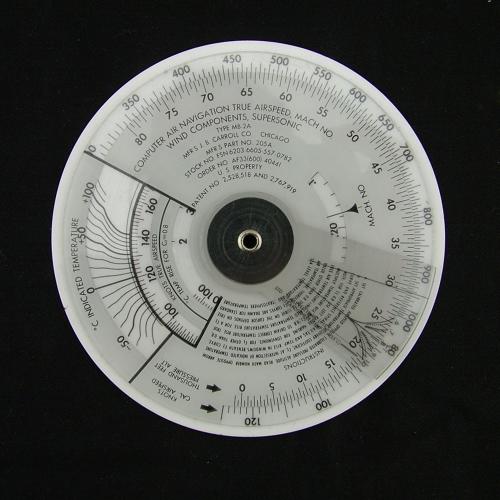

Rotate the inner scale so the Index is opposite 90, as shown in the figure.EXAMPLE: How far will the airplane fly in 8 min.Distance equals groundspeed multiplied by time. If you know groundspeed and time, you can determine the distance.Use your flight computer to solve these practice problems (answers are located below).on the inner scale or 1:12 on the hour scale. Under 120 on the outer scale read 72 min.Locate 120 NM, or "12," on the outer scale.Rotate the inner scale so the Index is opposite 100 kt., or "10," on the outer scale, as shown in the figure.EXAMPLE: How much time will it take to fly 120 NM at a groundspeed of 100 kt.?.Time equals distance divided by groundspeed. If you know the groundspeed and the distance, you can calculate the time.You can convert SM to NM or vice versa easily as explained in the preceding module.Note that in any problem both the speed and distance must be in either SM or NM.You can use your flight computer to make the above computations.With any two of these elements, you can compute the third (missing) element. Speed, distance, and time are three interrelated elements. Next, rotate "20" under "10" on the outer scale now all numbers on the inner scale are double those on the outer scale.Rotate the inner circle so the "10" is opposite the "10" on the outer scale, and note that all the numbers around both circles are identical.The calculator side of the flight computer is constructed so that any relationship, or ratio, between a number on the outer scale and a number on the inner scale will remain constant for all other numbers on both scales. The tick marks on the inner scale can be used to supplement the hour scale.Between "4:00" and "4:30" each tick mark represents 10 min. EXAMPLE: Between "1:50" and "2:00" the tick mark represents 5 min.On the hour scale, the tick marks represent either 5 min.EXAMPLE: 120 min., or "12" on the inner scale is also 2 hr.On the inner scale, minutes may be translated to hours and minutes by reference to the hour scale, which is below and inside the inner scale.The second tick mark to the right of "35" may represent 3.6, 36, 360, etc. The first tick mark to the right of "35" may represent 3.55, 35.5, etc.The first tick mark to the right of "17" may represent 1.72, 17.2, 172, etc.The first tick mark to the right of "10" may represent 10.1, 101, 1,100, etc.On both the outer and inner scales you will notice that the number of tick marks, or graduations, vary between numbers.The numbers on the outer and inner scales represent multiples of 10 of the values shown.In the center of the rotating portion are three "holes" (windows) used to compute corrected (true) altitude, density altitude, and true airspeed.This arrow is used as a reference to a rate, such as knots (nautical miles per hour) or gallons per hour.The number "60" on the inner scale has been replaced with a triangular-shaped arrow, referred to as the Index ( ).The inner scale is used to represent time, calibrated or indicated airspeed, and calibrated or indicated altitude, depending on the calculation being performed.The numbers on the edge of the rotating portion are referred to as the INNER SCALE in this document.The outer scale is used to represent distance, fuel, ground speed, true airspeed, or corrected (true) altitude, depending on the calculation being performed.The numbers along the outside of the stationary portion are referred to as the OUTER SCALE in this document.The calculator side consists of a stationary portion with a flat circular portion attached. FAA Safety Team – Promotional Request Form.Gleim Virtual Cockpit® BATD FAQs and Tutorials.X-Plane Flight Training Course – Multi User.X-Plane Flight Training Course – Home User.Gleim Virtual Cockpit™ BATD (FAA-Approved).Flight Instructor Refresher Course (FIRC).FIRC: Flight Instructor Refresher Course.


 0 kommentar(er)
0 kommentar(er)
